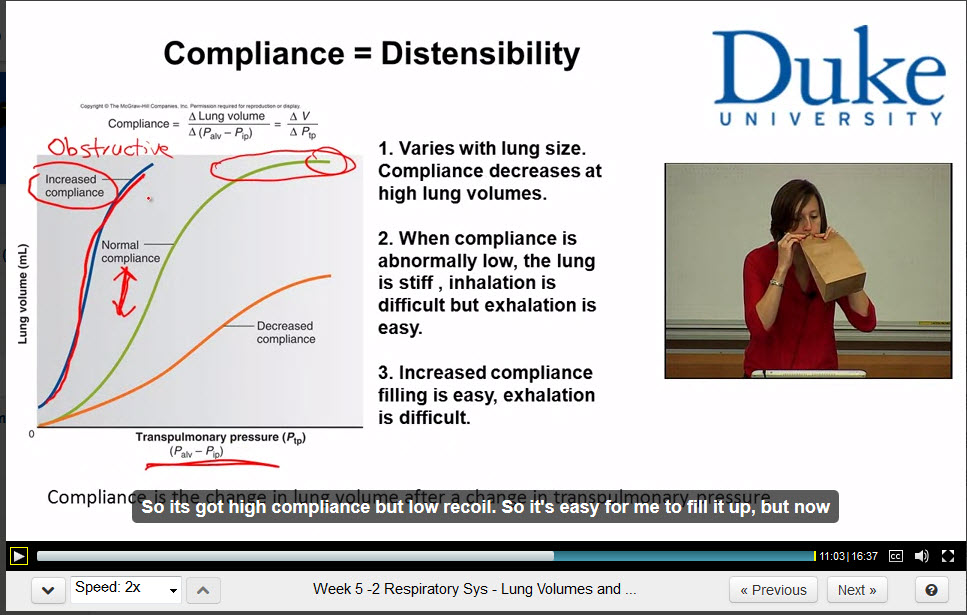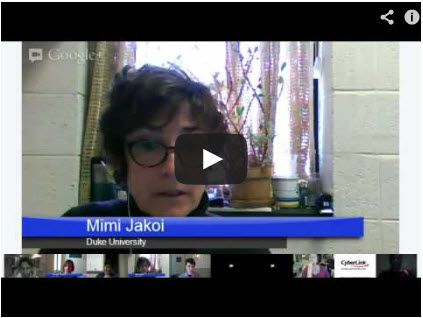Students from around the world have just completed a 12 week Duke MOOC, Introductory Human Physiology, taught by Emma (Mimi) Jakoi, PhD, and Jennifer Carbrey, PhD, both from the Department of Cell Biology at Duke University. Among the course’s 33,675 active participants, 1,036 earned a Statement of Accomplishment. One third of those who earned the Statement of Accomplishment qualified to receive the Statement of Accomplishment with Distinction.
Participants hail from more than 130 countries and of course include many aspiring doctors; however, the course also brought together people from very different walks of life, such as a Canadian farmer, an industrial engineer in Haiti, a person working his way through medical school in the summer, a police officer, a citizen of Pakistan pursuing her passion to learn, an asthma patient, and more.

From over 900 post-course survey responses:
- Roughly half of respondents indicated they earned the Statement of Accomplishment (52%) and the other half did not (48%).
- When asked to rate their overall experience in the course (where 1 = poor and 7 = excellent), the average rating for the course was 5.72.
- Half of the respondents thought the course difficulty was “just right”, whereas about 47% of the respondents thought the course was either slightly too difficult (38%) or much too difficult (8%).
- Overall satisfaction for the course was very high. A total of 92% of survey respondents indicated they were happy with what they learned in the course; 86% indicated they found the course materials were presented in an engaging manner; and 87% found course to be personally fulfilling.
- Some 59% of survey respondents indicated that they expect to perform better in their current or future work as a result of this course.
A student posted this comment on the course forum which received 59 up-votes from the student’s peers in the course.
“I just want to express gratitude to Coursera, the team behind this course and especially to Prof. Jakoi and Prof. Carbrey for delivering this important course to me and of course to so many others across the globe. Never did I imagine that I would have the opportunity to take a class taught by professors from a world class institution like Duke!
For me, it has been a pretty intense couple of months as the enlightening lectures unfold and I grapple with the frequently challenging yet compelling, sobering and incredibly fascinating material. Having pretty much flunked or close to flunking physics, chemistry and biology way back in the eighties, taking on this course was a big deal for me. I ended up dropping out of other MOOCs as I was committed to learning as much as I could from this course. Thanks to the hard work of professors and their clear delivery (and i know it takes many hours of preparation to deliver a good set of video lectures), i’ve gained a much better appreciation for the inner workings of the human body. You have given us a great peek, revealing its wondrous sophistication and elegance of design, its vulnerabilities and strengths. Also, thank you to the professors for diligently answering so many of the questions posted (including some of mine).
Another student also offered big thanks:
” I also want to thank Professor Jakoi and Professor Carbrey for this course. I really appreciated the opportunity and think the quality of the lectures and the provided notes were superb.
I hope the university realizes just how valuable you two are as instructors. You make us appreciate the complexity of our bodies but didn’t overwhelm us with detail. You know how to infuse joy and desire of learning more into the topic.
For all that, again big Thank You. 🙂 “
A student expressed nostalgic that the course is finished:
“Heartfelt thanks to the whole team- Drs. Jakoi, Carbrey and Bowers. I’ve learnt so much abt the human body. The best thing abt this course were the clinical examples. They have helped me to understand mine and my dear ones health issues. My mom even told me that I’ve learnt more from this “free” course than what I studied in college!! I’m a bit nostalgic that the course is finished and I cleared the exams.”
Learning Community
Drs. Jakoi and Cabrey have been amazed with how many people in the world love to learn and are willing to spend a lot of their time helping other people learn.

While already thousands of students joined the discussion forums in the course web site, there was also a range of other options for students to make connections with their peers and the instructors. students connected through Facebook, Skype and Google+ Hangouts. Online study groups formed by students spanned from an international Facebook study group to groups for specific languages, regions, or time zones, such as Greece, Malaysia, ”Global China,” Egypt, Portuguese speakers and students in the Eastern US time zone, Pacific Standard Time, etc.
Students put together a Course Wiki page where they shared notes, posted additional resources, and added revised lecture transcripts.
Dr. Jakoi commented, “These students avidly sought new information and generously shared their expertise, knowledge, and good will in support of others and the instructors. It was very interesting to see how quickly the community grew despite their diverse backgrounds and languages. It was humbling to hear of the sacrifices required of some in completing the course and/or in taking their exams. The students enrolled in this course were highly motivated learners.”
Challenges with MOOCs
Dr. Carbrey noted, “ The challenge that I have experienced is having enough personal interaction with our students. I have been enjoying the Google hangouts because I think they really help.”
Dr. Jakoi, “Of the several challenges that needed to be addressed, the most difficult was to teach in the absence of an audience. There was no immediate feedback, no student body language to read, and therefore no way to adjust one’s delivery. Not only do you not know if you are engaging the students but it is also very difficult to maintain an interactive dialogue in the absence of a recipient. How do you pose questions to a camera? In this format, a lecture is no longer interactive dialogue but simply a performance. The other challenges dealt with reformatting the course materials to conform with the requested 10 minutes video segments, to replace copyright materials, and to target the exams correctly, both in timing and style. Lastly there was the issue of how best to use the forum to engage the students in a dialogue and to foster the community.”
Tips for teaching MOOCs
Drs. Carbrey and Jakoi offered some tips to those who may teach MOOCs.
Carbrey – “The more materials you can use that have already been vetted by other students the better.”
Jakoi – “Each discipline will dictate how best to present the information. Some things that worked for us are as follows: First, a major advantage was to have most of the course materials prepared and loaded onto the course site before the MOOC started. The required time for conversion of the lecture ppts to the video format, for recording and for editing is not trivial. Second, we were very fortunate to have had really good support staff for loading the course site and monitoring the exams and forums. They minimized any delivery problems that could have arisen and were quick to fix those that did occur. Third, the students were often not fluent in English and had limited time to devote to the learning the course materials, to researching background information, and to taking the exams. To ease these issues, we issued hard copies of the ppts and the in video ppts, inserted reading periods before the exams in which no new materials were given and extended the time window for taking the exams. Fourth, the forums were divided into specific areas- content, technical problems, study groups, etc to provide an easy assessment of needs and to minimize chaos. Fifth, the Google Hangouts were useful in providing an interactive session with the students. They added a “human touch” needed by the students and by us. One note of caution is to be sure that the students understand how to “sign on” and to have a large pool of participants ready to go to avoid dealing with technical problems of “no audio” when live.”
Because of student interest and support, Introductory Human Physiology will be re-launched for a second run in August of 2013. This second iteration will be basically the same as the first version but will also include some edits to the videos, exams, and notes. To sign-up, go here: https://www.coursera.org/course/humanphysio.

Great work Prof.s Jakoi and Carbrey! Clearly, you have tapped into a huge unmet need in a creative and engaging manner. And thanks also to Haiyan Zhou and the whole CIT team for managing the success this and all the Duke MOOCs!